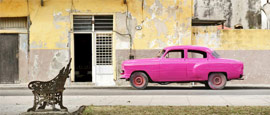Getting around Havana
Local buses are known as guaguas; service is notoriously slow, unreliable and crowded. Most visitors avoid them unless they are familiar with the routes. Service operates around the clock in theory but thins dramatically after 10pm.
Habana Bus Tour (tel: +53 7 261 1095), a hop-on, hop-off, double-decker affair, offers two loop routes: one takes in major tourist sites between Miramar and Habana Vieja, the other goes to the beaches at Playa del Este. Look for the blue and red signs at designated stops.
Havana features hard-currency Convertible Pesos (CUC) and collective, fixed-route taxis, which charge Cuban Pesos (also known as Moneda Nacional - MN). You can book CUC taxis by phone, flag them down in the street or find them outside the main hotels. Rates are determined by the taxi meter, though in practice drivers often negotiate an off-meter fare. Tipping about 10% of the fare is always appreciated.
Coco taxis are yellow, three-wheeled vehicles carrying up to three people; they're about half the price of regular taxis and you can contract them by day.
Arranging taxis by phone is reliable with CubaTaxi (tel: +53 7 855 5555).
Many car owners in Cuba act as licensed, freelance taxis; these cars (including pre-1960 models) can be hired per hour or per kilometre. The state company Gran Car (tel: +53 7 641 7980) runs a fleet of lovingly restored antique cars (including convertibles) serving as taxis.
There are a small but growing number of unlicensed taxi drivers operating out of Havana Airport and around Old Havana. While the vast majority of unlicensed journeys are incident-free, they can be avoided by looking for the official blue or yellow licence plates, or just by asking drivers to see their licence before taking a ride - they won’t be offended.
Bicitaxis
A pleasant way to move around the city is via bicitaxi – similar to Asian rickshaws with the driver pedalling from the front. There is no need to look for them as the drivers solicit tourists continuously. Rates are similar to normal taxis.
Havana traffic is approaching heinous and motorists will find driving in the city nerve-racking. Traffic lights may or may not be working for instance, and not all drivers observe traffic laws. Making a right on a red light is prohibited unless signs indicate otherwise. Road signage is improving, but still wanting. Havana’s grid system means navigating is straightforward, but hazards include meandering cyclists, pedestrians and stray dogs. Night driving is particularly difficult due to limited street lighting and many potholes.
Parking is in public lots and at hotels. Where there is no secured parking, it's worth paying someone a small fee to keep an eye on the vehicle if parking overnight. Never leave valuables in a parked car.
Hiring a car is the easiest option for visiting places not on interprovincial bus routes. However, it is an expensive way to move around within Havana and most people prefer taxis.
The minimum age for hiring a car is 21 years. An International Driving Permit is not required. You have to buy insurance locally. It is worth noting that a driver involved in an accident is judged guilty until proved innocent. Check for any damage and that all parts (windscreen wipers, lights, spare tyres, radio) are in good working order before driving off. Car radios, spare tyres and emblems are among the most commonly stolen items and often not covered by local insurance policies.
The two major car hire companies are Rex (tel: +53 7 836 7788; www.rex.cu) and Cubacar (tel: +53 7 835 0000), with main offices in town and at the airport. The former offers luxury rentals, the latter, compact cars and sedans.
Do you have any Feedback about this page?
© 2026 Columbus Travel Media Ltd. All rights reserved. No part of this site may be reproduced without our written permission, click here for information on Columbus Content Solutions.




 You know where
You know where